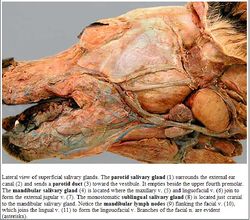Difference between revisions of "Zygomatic Gland - Anatomy & Physiology"
Jump to navigation
Jump to search
m (Text replace - "Salivary glands" to "Salivary Glands Anatomy & Physiology Flashcards") |
|||
| Line 9: | Line 9: | ||
<br> | <br> | ||
{{Learning | {{Learning | ||
| − | |flashcards = [[ | + | |flashcards = [[Salivary Glands Anatomy & Physiology Flashcards]] |
|powerpoints = [[Oral Cavity Histology resource|Histology of the salivary glands, see part 2]] | |powerpoints = [[Oral Cavity Histology resource|Histology of the salivary glands, see part 2]] | ||
}} | }} | ||
Revision as of 16:59, 30 June 2011
Overview
The zygomatic gland is found only in carnivores. The duct opens in a vestibule on the mucosal ridge by four or five orifices. It is innervated by the glossopharyngeal nerve (CN IX) via the trigeminal branch.
Histology
The zygomatic gland is a tubulo-acinar gland, made up of mainly mucosal cells (lighter stain). There are a few serous demilunes but they form only a minor contribution (darker stain).
| Zygomatic Gland - Anatomy & Physiology Learning Resources | |
|---|---|
 Test your knowledge using flashcard type questions |
Salivary Glands Anatomy & Physiology Flashcards |
 Selection of relevant PowerPoint tutorials |
Histology of the salivary glands, see part 2 |
